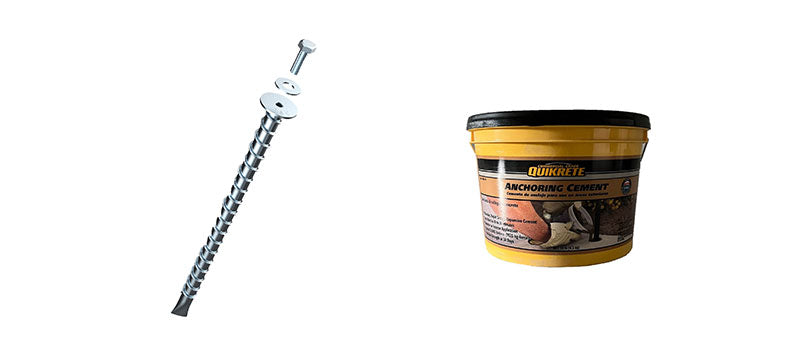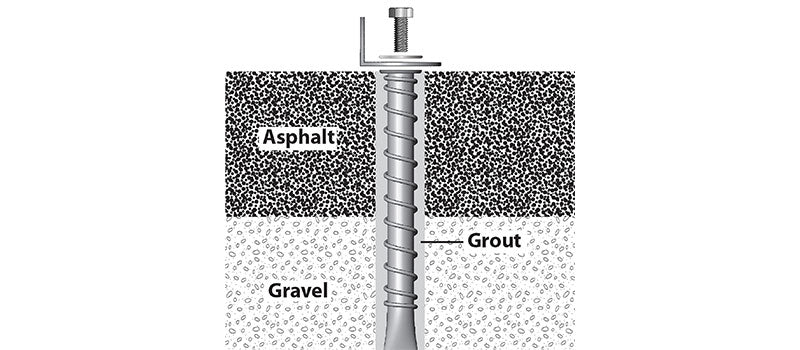 Anchoring a tent to asphalt is much simpler when you have a plan in place. There are several methods to successfully anchor a tent to asphalt surfaces. Continue reading to learn more about anchoring a tent with asphalt anchors, anchoring with stakes, and anchoring with weights.
Anchoring a tent to asphalt is much simpler when you have a plan in place. There are several methods to successfully anchor a tent to asphalt surfaces. Continue reading to learn more about anchoring a tent with asphalt anchors, anchoring with stakes, and anchoring with weights.
Methods to Anchor a Tent to Asphalt
Asphalt is a material that “creeps” under continuous pull stress. Creeping is when the asphalt experiences deformation and fractures due to too much pressure. The creeping that asphalt experiences, makes choosing the right anchoring method very important.
Tents such as canopies, awnings, and pavilions can be safely anchored to asphalt for various uses. Listed below are several tent anchoring methods to get the job done. For more in-depth information on how asphalt anchors work, check out the How to Anchor to Asphalt blog.
- Anchoring with Bolthold asphalt anchors and grout
- Anchoring asphalt anchors with post plates
- Anchoring asphalt anchors using eye bolts and straps.
- Anchoring with stakes
- Anchoring with weights
Heavy Duty Asphalt Anchors
Bolthold asphalt anchors are excellent fasteners for anchoring tents for temporary or long-term use. These anchor bolts are installed with Bolthold EPX2 cement based grout or EPX3 epoxy resin. The grout creates a stress-free bond that doesn’t weaken over time. Bolthold asphalt anchors can successfully secure tents with the use of post plates and eye bolts.
When deciding on whether to secure a structure using Bolthold asphalt anchors, it is important to understand how stable the object is on its own. If the object/structure stands solidly by itself, you can load the anchors at 80% of their pull rating. If the object applies a static pull force on the anchors just as it stands, limit the load on the anchors to 20% of the pull rating. View table 1 for each anchor’s tested pull rating.

How to Anchor a Tent with Post Plates
The first method for anchoring a tent with asphalt anchors is fixing the tent frame or posts directly to the asphalt surface. The anchors are installed in the asphalt and fastened through the holes in the plate.
Recommended steps:
- Remove the included bolt and washer from the anchor. This can be done 15 minutes after the grout is poured as long as the outside temperature is 75°F or higher.
- Make sure the plate you are attaching is flat. Align the holes in the plate with the anchors.
- Insert the washer and the bolt and tighten. Make sure you don’t exceed the torque. The required torque amounts are listed in table 1. (Do not use an impact wrench to tighten the bolt).
Recommended anchors:
- Use Sp12 anchors if the holes in the tent pole plates are less than 1/2″ in diameter.
- Use SP18 anchors to secure pole plates directly to the asphalt surface.

How to Anchor a Tent with Eye Bolts
The second method of anchoring a tent with asphalt anchors is using straps or guy wires to hold the posts or the tent’s frame. This can be successfully done with the use of eye bolts.
Recommended Steps:
- Install the anchors into the asphalt.
- Screw the eyebolt into the top of the asphalt anchor. The shoulder of the eye bolt needs to rest tightly against the head of the anchor.
- Tie the strap around the loop of the eyebolt. Bungee cords or flexible straps are recommended. They limit the pull forces applied to the bolts.
Recommended Anchors:
- Use Sp18 anchors if the tension in guy wires can be kept below 500 lbs.
For more technical information on installing asphalt anchors with eye bolts, check out the Eyebolts for Anchors Data Sheet.
How to Anchor into Asphalt
Listed below are the summarized steps to take when installing Bolthold asphalt anchors with the EPX2 cement-based grout. For detailed step-by-step instructions, follow the asphalt anchor installation guide.
1. Drill a hole into the asphalt surface to the diameter and length specified in the chart below.
 2. Use compressed air or a blower to clean dust from in and around the hole.
2. Use compressed air or a blower to clean dust from in and around the hole.
3. Pour a pre-measured volume of water into a mixing container. The quantity of grout created varies depending on the amount of water used and the consistency of the mixture. Use the table below to estimate the amount of water and grout required for four anchors.

4. Slowly add the EPX2 grout powder to the water and stir continuously. The consistency of the mixture should be syrup-like for best results.
5. Slowly pour the grout mixture into the hole. Make sure the adhesive fills each hole from the bottom to a little above the asphalt surface. Not filling to the top of the hole will significantly weaken the anchor and the asphalt. To eliminate air pockets, poke the grout with a thin tool.
6. Push the anchor into the hole with a slow down-up motion so the entire length of the anchor is covered by the mixture. Within 15 minutes, the anchoring grout will begin to cure. The full cure time is about 1 hour. To avoid issues, wait 2 hours before exerting a pull load or a heavy torque on the anchors. Lastly, wait 24 hours before performing a pull test on the anchors.
How to Remove Asphalt Anchors
In situations where your anchor needs to be removed, the best time to do this is immediately after installation. It is much easier to remove the anchor before the grout has fully cured. This would be within 15-60 minutes after pouring the grout.
The best way to remove the fastener is to use a socket or wrench. Over-tighten the bolt to the point where the entire anchor will rotate and break away from the adhesive. As the anchor rotates, also rotate it counterclockwise. This method may pull it out. If this does not work, use a nail puller or two large flat screwdrivers. Place the tool under the anchor’s head to lift it out. After removal, the anchors are reusable for the next job.
Tent Anchor Stakes
Tents can be anchored to asphalt with stakes also known as tent pegs. Anchoring with stakes is very common for anchoring a camping tent to the ground. However, with asphalt, the process of staking is a little more extensive. First, a hole needs to be drilled in the asphalt.
Next, a large stake needs to be drilled into the hole. Once the stake is secured in the ground, tent straps can be used with the stakes to anchor the tent. After you are done using the tent, remove the stake from the asphalt and patch the hole.
Tent Anchor Weights
Anchoring tents to asphalt with weight is a common method for situations where it is not permitted to drill into the asphalt to install stakes or anchors. The weight should be placed on every leg of the tent.
The disadvantage of using tent weights is the transporting of the weight. This solution is more labor-intensive especially for a large tent that requires a lot of weight to hold it down. Depending on the size and type of tent you are using, the weight required to anchor it to asphalt will differ. Check with the tent manufacturer for the specified weight.
Common Tent Weights:
- Sandbags
- Concrete blocks
- Water weights
- Weight plates
Find it Fast. Get it Fast.
Fasteners Plus carries a variety of screws, connectors, anchors, nails, power tools, and more! Place your orders at FastenersPlus.com and our dedicated team will get quality products sent to you. If you have any questions about fastener options, please do not hesitate to reach out to our Product Experts at (888) 794-1590 or by email at customerservice@fastenersplus.com.
